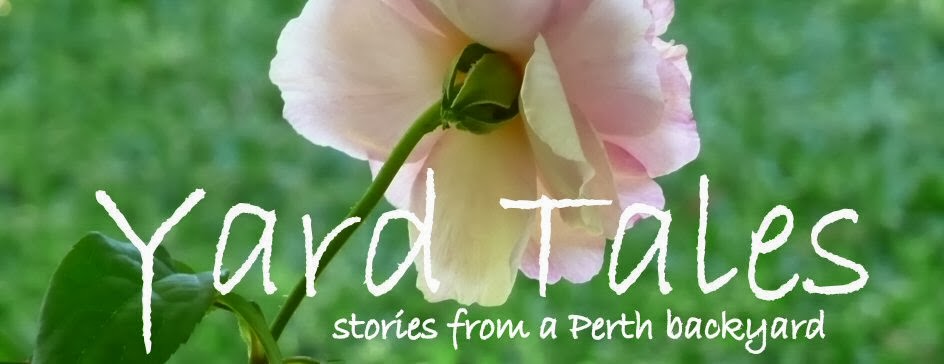Winter
is here in Perth. Over this week we’ve been lashed by a wild storm with rain,
hail and high winds. When I went for my half hour lunchtime stroll on Monday I
found myself completely drenched from knee-level down in a 30 second downpour,
doing my very best Marcel Marceau impersonation and then putting on sunglasses
for the last 10 minutes. A meteorologist I heard on the radio described the
weather as ‘vigorous’.
In
this post I want to talk about my Washington Navel orange tree, which has
fruited for the first time this year. Citrus
trees seem to be very slow growing and I like to get some height before I let
my trees fruit. Even so it is only about 4 ½ feet high after 5 years. They are
delicious and heavy for their size and, therefore, juicy. Which is a relief. I
was never sure if I was giving it enough water for good fruit over summer. Too
little and they will be small and dry, too uneven and the fruit will split – or
so I’m told.
This
is a dwarf Meyer lemon. My original plan was to keep this in a pot and so I let
it fruit even though it was in its first season. I far prefer plants to be in
the ground where they take care of themselves and, with bit of shuffling, I
have found a spot for it. I’m very impressed with it. Snails ate a lot of the
early fruit, which is probably a good thing.
Apart from the Washington Navel I have an early fruiting orange variety, a Navelina orange which is now 3 years old, and another tree that I bought last year, a semi-dwarf Cara Cara orange, which is sold as Rosey red oranges in stores here. The Cara Cara is not a blood orange but a pink toned navel orange.
I
follow a fairly hefty fertilising regime for them, adding granular fertiliser
in spring, summer and autumn as well as mulching with compost in spring. Even
so, the leaves show signs of mineral deficiency in the sandy soil. This is
where Charlie Carp liquid fertiliser comes to the rescue. Charlie Carp
fertiliser is made from the pesky and destructive European carp which infests
rivers in the eastern states. It also has added minerals which increase its
usefulness in the case of citrus trees and the depleted sandy soils which
plague Perth.
I
first discovered C. Carp when I decided to recycle some hand washing water. I
decided I could wash my hands in a plastic bowl in the laundry, and by using
grey water friendly soap I would be able to recycle it onto the garden. I
tested its pH level by watering my hydrangea with it. With an application of
compost the flowers hover somewhere in between pink and blue. Adding the
recycled water turned the flowers bright pink so the solution seemed to be
adding a liquid fertiliser to it. After investigation (well… googling really) I
found Seasol and PowerFeed were alkaline, Charlie is acidic.
In
summer I need to give my citrus trees (larger ones anyway) 4 capfuls of Charlie Carp
in 2 buckets of recycled water every two to three weeks. This is mostly worked
out by eyeballing the plant and if it looks a little peaky I will feed it. Over
the cooler months it needs less and reduces down to around once every four or
five weeks.
Apart
from fertilising I give all my fruit trees an extra 10mm of water per week than
the rest of the garden. Give it a try!





No comments:
Post a Comment